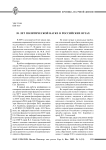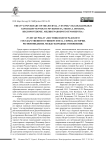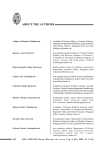Вестник ВолГУ. Серия: История. Регионоведение. Международные отношения @hfrir-jvolsu
Статьи журнала - Вестник ВолГУ. Серия: История. Регионоведение. Международные отношения
Все статьи: 1870
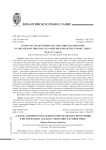
Статья научная
Введение. Иоанн Газский - единственный известный нам поэт-грамматик, принадлежащий к культурной среде Школы Газы. Его сочинение «Описание картины мира» является уникальным дошедшим до нас поэтическим произведением, которое соответствует античному литературному жанру. Несмотря на окончательную христианизацию Газы в конце IV в., классические элементы не изжили себя. Яркий пример - поэма Иоанна Газского, написанная в жанре экфрасис. Автор рукописи при создании поэмы активно обращался к произведениям античных авторов и в меньшей степени - христианских. Поэтому главная цель нашего исследования состоит в выявлении источников - точных цитат, выражений, которые могут быть идентифицированы в другой работе, - перефразированных или повторяющихся дословно. Методы. Автор проводит свое исследование на основе историко-сравнительного метода, позволяющего сопоставить сочинение Иоанна Газского с произведениями других авторов. Таким образом, это позволяет выявить источники, используемые в поэме. Анализ. Автор в своей работе разделяет условно цитируемых авторов на античных и христианских, а также аргументирует тезис, что важное место в качестве источника заимствований занимают произведения первых. Результаты. На основе проведенного анализа автором были выявлены четыре основные характеристики, которые явно указывают на отголоски культурного наследия античности. Толкование и понимание аллегорических и христианских образов в ранней Византии с помощью Гомера, Нонна Панополитанского, Аристофана, Менандра и других занимало по-прежнему существенное место в жизни газийцев. Цитирование же христианских авторов, в первую очередь Иоанна Златоуста, объясняется историческим временем, связанным с трансформацией религиозного сознания. В целом можно отметить, что стихотворение византийского поэта Иоанна Газского является «сплавом» античного наследия и христианского вероучения.
Бесплатно
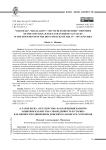
Статья научная
Введение. Донское казачество в период перехода от вольности и самостоятельности во времена Московского государства переживало процесс своего становления в качестве служилого сословия Российской империи и постоянно вело борьбу за справедливость в отношениях с российскими властями. Эта борьба проявлялась через отношение к старине, признававшейся соответствовавшей справедливости, и к новизне, которая воспринималась как нарушение справедливости, но со временем становится новой традицией, соответствовавшей представлениям о справедливости.
Бесплатно
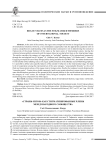
"Страны-изгои" как стигматизированные члены международного сообщества
Статья научная
Статья рассматривает категорию «стран-изгоев» в качестве «отверженных» членов мирового сообщества через призму социологических концепций «стигмы» И. Гофмана и теории «клеймения» Г. Беккера и Э. Лемерта. Подобный подход открывает возможности для выявления двух порогов включения государства в группу «изгоев»: «публичной инициации» нарушителя и «самовоспроизводящегося пророчества», вследствие пересечения которых формируется девиантная карьера актора. Среди характерных поведенческих характеристик аутсайдера можно выделить высокую степень кооперации с представителями собственной категории, «неустойчивую браваду» и стремление к получению вторичных выгод, связанных со стигматизированным статусом. В свою очередь глобальное сообщество (за исключением группы «понимающих») склонно к проявлению повышенного внимания к «изгоям» и их дискриминации на основе ненормативного положения в международной структуре.
Бесплатно
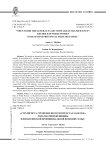
Статья научная
Статья посвящена роли женщин в семьях византийской провинциальной военной знати в середине IX - середине XI в. В историографии данный вопрос остается малоизученным, хотя его актуальность в связи с активизацией в последнее время исследований, посвященных повседневной жизни византийского общества, сомнений не вызывает. Наиболее важная информация по теме статьи содержится в византийском эпосе (прежде всего, в поэме «Дигенис Акрит»). Одним из ключевых образов данных литературных произведений являлся образ стратигиссы (Ѕ уфсбфЮгйууб, «жена стратига»). В отсутствие мужа, служившего в императорской армии, она занималась домашним хозяйством, вела переписку с родственниками и соседями, устраивала свадьбы своих детей, разрешала семейные конфликты. В случае вражеского набега стратигисса заботилась о выкупе пленных. По мнению авторов, ответственность, возложенная на стратигиссу, предоставляли ей значительную свободу, она обладала особым социальным статусом в мире византийского пограничья. Для подтверждения своей аргументации авторами были привлечены данные сфрагистики. В статье проанализирована группа из 14 печатей середины X - середины XI в., принадлежавших женам византийских военачальников. Наиболее важными из них следует считать печати стратигисы Елены (1.2) и стратегиссы Екатерины Мелисины (2.2), а также буллу Константины Пекулины, топотиритиссы Кивирреотов. Предположение авторов о том, что во второй половине X в. жены стратигов для опечатывания частной корреспонденции использовали буллотирии своих мужей, является дискуссионным; данный вопрос требует дальнейшего изучения.
Бесплатно
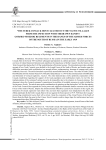
Статья научная
Статья рассказывает о создании Горско-Моздокских полков Терского казачьего войска в начале 1919 г. и их последующем участии в боевых действиях. Приведен краткий обзор историографии по данному вопросу, сформулирована важность дальнейшего изучения истории Терского казачьего войска в годы Гражданской войны и публикации исторических источников. Во вступительной части подробно рассказывается об обстоятельствах призыва терских казаков в ряды Вооруженных сил Юга России (ВСЮР), возникших в связи с мобилизацией сложностях (отсутствием достаточного количества офицеров, некомплект личного состава, отсутствие необходимого вооружения и эпидемии тифа). В публикации вводится в научный оборот недоступный ранее исторический источник - приказ атамана Моздокского отдела Терского казачьего войска есаула С.Н. Портянко от 17 января 1919 г. о начале мобилизации и создании казачьих полков. На примере приказа видны чрезвычайно оптимистические расчеты казачьего командования на поддержку населения и соответствующие результаты мобилизации. Реальность показала невозможность быстрой реализации планов командования с учетом ситуации в казачьих станицах. Документ показывает готовность казачьего командования мобилизовать все силы для достижения победы в борьбе с советской властью. При подведении итогов указано, что Терское казачье войско в годы Гражданской войны в своем большинстве выступило противником советской власти и дало немалые пополнения ВСЮР. Несмотря на указанные сложности, связанные с обстановкой в регионе, в войске в целом успешно проходило формирование казачьих полков, выдвинутых вскоре на фронт. Усилия Терского казачьего войска для борьбы с советской властью в 1919-1920 гг. характеризуются чрезвычайным напряжением сил для победы в войне. После эвакуации ВСЮР с Черноморского побережья в Крым терские казаки, лишившиеся возможности пополнения, были включены в состав других белых частей. Авторский вклад в создание статьи произведен авторами в равных долях. При написании материала Р.Г. Гагкуевым и С.Г. Шиловой проанализирована источниковая база и историография вопроса, подготовлен к публикации исторический источник из Российского государственного военного архива, сделаны примечания и комментарии к публикации.
Бесплатно
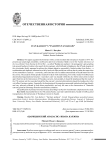
"Царицынский анабасис" Ивана Карлова
Статья научная
В работе анализируется любопытный эпизод из жизни города Суздаля, освещающий неудачную попытку высылки оттуда в Царицын в 1674 г. посадского человека Ивана Карлова. Благодаря публикуемым в приложении к статье документальным свидетельствам автору удается показать децентрализованный характер организационной структуры Суздальской приказной избы, а также важную руководящую роль стройщиков Суздальского Покровского девичьего монастыря в ее повседневной деятельности.
Бесплатно
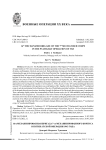
16-я механизированная бригада 7-го механизированного корпуса в Пятихатской операции 1943 года
Статья научная
Пятихатская наступательная операция Степного (2-го Украинского) фронта завершает череду крупных сражений 1943 года. На сегодняшний день она остается малоизученной, особенно в вопросе о действиях отдельных частей (корпусов, дивизий, бригад). Рассекречивание большого комплекса архивных материалов позволяет постепенно ликвидировать этот пробел в историографии Великой Отечественной войны. Проведение объективного анализа журналов боевых действий, сравнение с ранее опубликованными источниками позволило рассмотреть участие 16-й механизированной бригады на первом этапе Пятихатской операции с 15 октября по 5 ноября 1943 года. В статье изучаются процесс формирования и подготовки бригады в июле-сентябре, прорыв немецкой обороны, освобождение г. Пятихатки и других населенных пунктов с 15 по 21 октября 1943 г., оборонительные бои на подступах к Кривому Рогу (с 21 октября по 4 ноября 1943 г.). Введенные в научный оборот материалы показывают героизм и мужество бойцов бригады, достаточно эффективное руководство боевыми действиями офицеров бригады и всего командования 7-го механизированного корпуса. Вклад авторов. Д.И. Тушкановым изучена историография и опубликованные источники по теме исследования, проанализирована история формирования 16-й механизированной бригады и ее взаимодействие с другими частями 7-го механизированного корпуса. И.В. Тушкановым на основе журнала боевых действий рассмотрена боевая деятельность и взаимодействие подразделений бригады в ходе Пятихатской наступательной операции.
Бесплатно
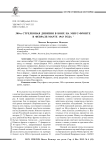
300-я стрелковая дивизия в боях на Миус-Фронте в феврале-марте 1943 года
Статья научная
После окружения немецких войск и их союзников под Сталинградом в конце ноября 1942 г. Красная армия смогла развить масштабное наступление на запад, и в январе - начале февраля 1943 г. войска Южного фронта нанесли удар на ростовском направлении. Данная статья посвящена боевым действиям 300-й стрелковой дивизии 13-го гвардейского стрелкового корпуса 2-й гвардейской армии в начале 1943 года. Упоминания о них практически отсутствуют в историографии, между тем в боях в феврале - первой декаде марта дивизия понесла огромные потери и была отведена в резерв. Опираясь на рассекреченные документы Центрального архива Министерства обороны Российской Федерации, автор раскрывает одну из малоизвестных страниц истории Миус-фронта.
Бесплатно
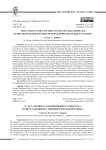
9-е и 17-е правила Халкидонского собора 451 г. в свете западного соборного наследия IV века
Статья научная
Введение. Статья посвящена проблеме интерпретации 9-го и 17-го канонов Халкидонского собора 451 г., в которых регламентируется практика разрешения тяжб между представителями духовенства. Особое значение имеет предписание разрешать споры, в которых участвуют митрополиты, через обращение к экзарху диоцеза или Константинопольскому престолу. Эти каноны зачастую рассматриваются как основания вселенского первенства и особых судебных прерогатив Константинопольской кафедры во всей Православной Церкви. Методы. Учитывая статус Константинополя как Нового Рима, автор сопоставляет содержание 9-го и 17-го правил Халкидонского собора с постановлениями Сердикского собора 343 г. и Римского собора 378 г., касающимися судебных прерогатив Римского престола. Анализ. В результате в статье подвергается критике получивший распространение в историографии тезис об аналогичности 9-го и 17-го правил Халкидонского собора и так называемых апелляционных канонов Сердикского собора. В то же время в послании Римского собора 378 г. и рескрипте императора Грациана, ставшем ответом на этот текст, присутствует некоторое сходство с халкидонскими постановлениями. Например, в решениях и Римского, и Халкидонского соборов обозначена идея альтернативности в выборе судебной инстанции. Их общей особенностью является также представление о невозможности производить судебный процесс по делу митрополита на уровне провинции. При этом если в постановлениях Римского собора речь идет о рассмотрении обвинений в тяжелых преступлениях, то в канонах Халкидонского собора - об арбитраже в тяжбах. Результаты. Несмотря на некоторые различия, постановления Римского и Халкидонского соборов неразрывно связаны с общими тенденциями развития системы церковной организации на сверхпровинциальном уровне.
Бесплатно
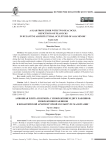
Статья научная
This paper presents a marble slab from the Archaeological Museum of Izmir in western Turkey, which was published by Anastasios K. Orlandos in 1937 and its inscription was re-considered by Georg Petzl in 1990. Its epigraphy mentions a formerly unknown bishop, Euethios, who was probably the bishop of Smyrna during the Early Byzantine period. On this occasion, a brief review of the depiction of two peacocks flanking a vase in the marble architectural sculpture of Byzantine Asia Minor is presented, in order to assign a more concise date for the slab from Izmir. An accompanying catalogue with several examples of peacocks’ depictions from Asia Minor was made and a marble plate with a peacock depiction from Skopje, Macedonia is also included. Authors’ contribution. In this article Ergün Laflı gives a detailed description of this inscribed plate which is a valuable historical document, while Maurizio Buora analyses its inscription and makes its epigraphic assessment as well as a systematic examination of the iconography of peacocks in the marble architectural sculpture of Byzantine Asia Minor through over thirty examples in Turkish museums.
Бесплатно
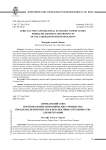
Статья научная
Introduction. African Union’s regional economic communities are stronghold for the African continent towards economic integration in various sub-regions and sectors of the African people. Their efforts have further deepen both trade and political interests among them which have equally boosted the integration drive of the African Union for the overall benefits of the Africans. Their moves have articulated many incentive, for more investments and attraction of Foreign Direct Investment that have brought continental reforms like stabilization, market policy, liberalization and privatisation methods adopted for regional arrangements to increase both private and public investments. Methods and materials. The paper adopts secondary source of data to elicit information while it makes use of the study towards economic, monetary market development and political union in African. Analysis and Results. The paper posits to examine their areas of dimensions, problems and prospects for collaboration to maximize economic goals and objectives which include security governance, economic growth, etc. The paper identifies problems like over concentration with the regional economic communities and their attendant peculiarities, while it notes the prospects of joint activities between the African Union and the regional economic Communities to build their capacities, harmonize and coordinate their institutions towards collaborations.
Бесплатно
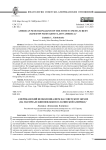
American neocolonialism on the Soviet cinema screen (based on films about Latin America)
Статья научная
Introduction. The scientific relevance of the topic is due to the fact that the concepts of colonialism and neocolonialism are currently becoming part of the official Russian political discourse. The article examines how film representations of the struggle against American neocolonialism in Latin America are used to create the image of the American enemy in the context of the Cold War, which determines the novelty of this work. Methods and materials. The article is based on Soviet features and documentary films about Latin America. Analysis and results. The author comes to the following conclusions: images of neocolonial exploitation of Latin America contributed to the creation of the image of the American enemy, endowing it with such features as immorality, greed, cruelty, and contempt for the population of the Third World. In addition, the images of Latin America and the struggle of its population against neocolonialism were used in the politics of Soviet identity. A demonstration of solidarity with the people of Latin America maintained the image of the USSR as the leader of the liberation struggle against (neo)colonialism. The struggle against pro-American governments in Latin America acquired legitimacy through images of the plight of the countries ruled by powers accomplishing American neocolonialism. Films about the Cuban and Nicaraguan revolutions served to predict victory over neocolonialism in the region in particular and the American enemy in the Cold War in general.
Бесплатно
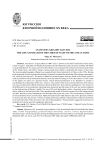
Anamnesis Grigory Baturin. Жизнь и смерть начальника штаба Таманской армии
Статья научная
Введение. Григорий Николаевич Батурин (1880–1925) вошел в историю как начальник штаба Таманской армии, которая в августе – сентябре 1918 г. совершила переход от Черноморского побережья к Армавиру, прорвав блокаду белоказачьих отрядов. Оставшиеся годы жизни Батурин был связан с воинскими частями, сформированными на основе Таманской армии, с товарищами-таманцами, предприняв много усилий по увековечиванию истории этой армии. Наиболее полную биографию Батурина составил советский историк Н.А. Ефимов в 1970-е годы. Однако в силу ограничения доступа к личным документам он воссоздал внешнюю канву жизни военкома. Методы и материалы. Открывшийся доступ к широкому перечню личных бумаг Батурина из фондов двух ростовских архивов позволил уточнить сведения о его деятельности с весны 1919 г. до лета 1920 г., которые ранее имели поверхностное описание. Часть бумаг составляют письма личного характера, что позволило провести психиатру А.Я. Перехову психолингвистическую экспертизу текстов. Анализ. Содержание послужного списка героя очерка не всегда подтверждается официальными сведениями о РККА из справочных изданий. Причины отличий кроются в механизме прохождения армейских документов, самом характере Гражданской войны и объясняются ухудшением здоровья Батурина. Образ жизни и отношений внутри сплоченной группы бывших однополчан в первой половине 1920-х гг. воспроизводили сложившуюся в годы войны модель жизни и быта командного состава и их семей при армейских штабах. Реконструированы обстоятельства частной и семейной жизни Батурина. Медицинские документы предоставили объективные данные о его физическом состоянии в последний год жизни. Результаты. По уровню снабжения и бытовым условиям представители провинциальной элиты в первой половине 1920-х гг. были близки к остальной массе населения. Психиатр предположил наличие постепенно усиливающейся рекуррентной эндогенной депрессии.
Бесплатно
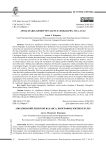
Apollinaris, Bishop of Valence: Biography, Vita, Cult
Статья научная
Introduction. Apollinaris, bishop of Valence, was the brother of the famous Avitus of Vienne, but his biography is practically limited by that. Apollinaris was canonized in Merovingian times, and the only source that can expand our knowledge is the Life of Apollinaris. This hagiographical text about the last years of the life of Apollinaris reached our time. The Life was first published in the 17th century and was considered a reliable Merovingian text, but in the 19th century, the German researcher B. Krusch suggested that it was a Carolingian forgery. In this connection it is necessary to analyse the authenticity of the Life and the relevance of the information it contains about the bishop’s own personal history and cult. Methods and materials. The study of the Life has been carried out on the method of critical analysis and the biographical method. Analysis. A critical analysis of the Life, along with verification of its dating and the reliability of the data concerning the time of the saint’s lifetime, has enabled the refutation of B. Krusch’s arguments, which asserted that the text was a Carolingian forgery. The author compiled the text in the first person and adequately reflected the realities of the early sixth century. The Life was written by a contemporary who personally accompanied the saint on his journey to Arles and Marseilles. This trip was made after the Burgundian king Sigismund was overthrown in 523, when the Gallic prefecture of the Ostrogothic kingdom took over Provence up to the Isere River. Since, according to the Life, Apollinaris died soon after this journey, it is possible to assume that the death of the saint himself occurred around 524–525. Results. The Life of Apollinaris is a reliable source and is an example of Merovingian hagiography of the mid-6th century. This text allows us to reconstruct the last years of Apollinaris’ life and to determine the time of his bishopric as 490/491–524/525. In addition, the Life demonstrates that the cult of St. Apollinaris began to develop immediately after the saint’s death.
Бесплатно
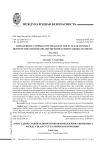
Статья научная
Introduction. Film offers a valuable mirror to reflect on how we assess our present and past. The Cold War was one of the most troubled periods in history. Two huge, wealthy, energetic, and creative societies competed in all areas. During those decades of electric change and development they faced each other with weapons of ever increasing lethality. The film industry in both countries looked at how the nuclear exchange would impact in both lands. Over the decades as the weaponry changed, as the patterns of leadership changed, as the economy of the world evolved, both nations’ film industry painted different images of what Armageddon could look like. If we compare comparable films, across similar decades, what do we learn of that era and those people? Methods and Materials. The methods used in the article are comparative, analytical and functional systematic ones. The materials used are the following: 1) five films of both cultures from different decades; 2) secondary accounts of contemporary events; 3) secondary reviews of the selected films, and 4) secondary accounts of parallel incidents. Analysis. With the complex weapons of the Cold War era we certainly need to worry about the technological imperative and the potential role of accident and unintended consequences. However, we are blessed that the doom day scenario has not yet erupted. We are most fortunate that the dire warning of many US filmmakers have not been realized. Indeed with the coming advent of AI technology and 5G communications, we may have more to fear than ever before. Results. After fifty some years of the Cold War, films continue to project the worst fears of people. As we review these films across the several decades we see constancy, the films again and again distrust technology.
Бесплатно
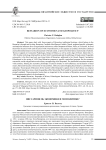
Bessarion on economics and geopolitics
Статья научная
This paper deals with those aspects of Byzantine intellectual heritage, which belong to the Bessarion’s thought and writing. Bessarion, Cardinal of the Roman-Catholic Church, proposed specific, systematic and analytical measures for a re-organization and recovery of the Despotate of Mistra, while, as it is known, he lived there from the end of 1431 until the end of 1436. Then Вessarion, in his capacity as cardinal, showed his continual and undiminished interest to the advancement of Greek nation, as proven by three famous memoranda of scholar. These are appeals to Constantine Palaiologos, Despot of Mistra, as well as to the doge of Venice. Dated July 13, 1453 the letter to the doge informed him on the Fall of Constantinople and the sufferings of Greek nation! Especially noteworthy is the third (and only surviving) letter of Вessarion, addressed to his friend, Despot Constantine Palaiologos in the spring of 1444. Here Вessarion proposes a specific, specialized program for the economic restructure, social reorganization and military strengthening of the Despotate. The intellectual associates education with economy. Sharing the economic philosophy of ancient Greeks on self-sufficiency and utilization of local means, Вessarion became a forerunner of mercantilism, while also acknowledging the productive contribution of education. The proposal of Вessarion for the transfer of the Despotate’s capital closer to the Isthmus was of great geopolitical importance since, when the guarding of the Hexamilion Wall would be reconstructed and constant and properly updated. These proposals, having been so important for the evolution of Byzantine economic thought, took an appropriate place in its development.
Бесплатно
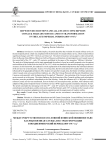
Статья научная
Introduction. As the title implies, the article describes the evolution of Cossack military service in the late imperial period, which was completed with the formation of Cossack military service, which existed without significant changes until 1917. Methods and Materials. The article is based on various papers: archival materials from the Russian State Military Historical Archive (Moscow), publications of contemporaries on Cossack issues of the second half of the 19th - early 20th centuries, published in the pages of the magazine “Military Collection.” The analysis of historiography on the topic capacitated the author to reveal an overall perspective on the content and evolution of the Cossack service from 1835 to 1917, which was detailed in the narrative acquiring a multi-level structure. In this framework, the emphasis is on the explanation of the relationship between the individual elements of the service over several decades. Analysis. For a long time, the form and content of Cossack military service were influenced by the geographical features of the location of a specific Cossack army, the theater of military operations, where Cossack units were used, military traditions, etc. After the Crimean War and with the end of hostilities in the Caucasus, and especially with the beginning of the epoch of “liberation”, the evaluation of the Cossacks and their service moved on to the press. The main platforms for the discussion of the Cossacks military and colonization functions were the periodicals subordinate to the War Ministry. Under the influence of D.A. Milyutin’s military reforms Cossack service was transformed, first on the basis of a conscription order, and then, with reference to the adoption of the general imperial Charter on military service (1874) it again acquired a mandatory character. Results. The article concludes that emerging in the late 19th - early 20th centuries the service system implied more rigid centralization and unification, and the entire policy of the War Ministryuntil 1917 in relation to the Cossack service was aimed at its maximum adaptation to the army regulations and the requirements of modern warfare.
Бесплатно

